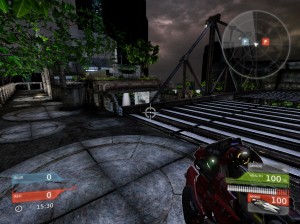by Annie | Sep 27, 2010 | Game Design
On my way back into town from a wedding this weekend, I decided to start sketching out some ideas for my next level design concept. Being on an airplane without internet access, I had to draw inspiration from the resources available to me, namely the various airport maps within the in-flight magazine. As I was sketching, I could feel the guy in the seat next to me eyeing my drawings curiously, checking my progress every so often to sneak peeks at room layouts, weapon placements, and ideas for cinematics. In that moment, as I saw myself through his eyes, I remembered what an incredibly fun and creative field game design is. Every day, I get to pull inspiration from movies, news, science, and the world around me to create entertaining interactive experiences. I’m in the business of creating fun, and what can be more fun than...

by Annie | Sep 23, 2010 | Game Design
Capture the flag. Such a straightforward game, yet with infinite possibilities. Some of the most memorable CTF maps have been incredibly simple – two bases connected by a winding road. Other maps include transporters, secret passageways, and flying vehicles. Over the past couple of weeks, we were tasked to work in pairs to create our own CTF levels using the Unreal Engine. Several brainstorming sessions in, my partner Chris and I decided on a rooftop CTF level featuring a variety of pathways on multiple levels. Take a...

by Annie | Aug 31, 2010 | Game Design
Creating a level from scratch can be fun. You get to decide where to put different obstacles, how to guide players, and when to provide rewards. Creating a level using unfamiliar technology, however, can be downright intimidating. Recently, we started using UDK (Unreal Development Kit), a game engine created by Epic Games that provided the basis for games like Gears of War, Bioshock, and Mass Effect. Luckily, with a manageable assignment and supportive instructors, our first experience in the UDK pool was more of a gentle splash rather than an embarrassing and painful belly flop. When working in UDK, you can build through a variety a views: top, side, front, and perspective. This is all to ensure that the assets are integrated seamlessly, providing total gameplay immersion. Our assignment was simple: create two rooms linked by two corridors. Here are a few screenshots from the level I created: Hopefully, with more practice, I’ll soon be able to create entire cities in UDK. Stay...
by Annie | Aug 12, 2010 | Game Design
Imagine that you live on a space station. Alone. Tonight, you have a date. The first in a long time. You plan on cleaning up the space station and getting yourself ready, but you discover that alien slugs have taken over. What do you do? Pelt them with salt, of course. This is exactly what my Google SketchUp white-box level is about. Take a...

by Annie | Aug 1, 2010 | Game Design
As a teacher, I wore many hats every day. Teaching aside, I regularly took on the roles of nurse, psychologist, event planner, secretary, statistician, and fellow kid. Being able to wear many hats is also one of the reasons I love studying game design. As a game designer, I must juggle the demands of budget and schedule with the creative elements of cinematography, storyline, and character and level design. I am by no means an expert, but as you may well know, I always welcome a challenge. This past Friday, I finally went to see the movie Inception. Though it was the third Friday since the movie’s release, the theater was still packed. I won’t spoil the movie for those of you who haven’t yet experienced its intense storyline, but suffice it to say that the movie has a lot in common with game design. Inception explores the possibilities of the human mind, and, in particular, of its dreams. Like game environments, dream worlds must be carefully architected. Though pieces of the dream or game may come from real life inspiration, the ultimate dream or game world is a conglomeration of the best parts of the real world. This weekend, I took on the role of a level designer. Well, kind of. My assignment was to analyze an existing game level and create a level map detailing the environment and obstacles. Sounds simple enough, right? Well, keep in mind that you have to know the level well enough to draw the map (i.e. you have to play the level over and over again). Then, you have to draw the level...



